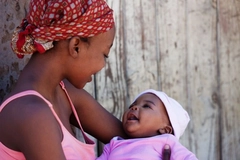East and Southern African alliances to tackle malnutrition with Indigenous foods
A new parliamentary alliance in South Africa is seeking to advance legislative reforms and boost oversight to address food security and nutrition challenges. Meanwhile, East African nations have agreed to promote legislation to increase African traditional, indigenous, nutritious and forgotten foods, as well as non-timber forest products.
Eight nations have formed the Eastern Africa Parliamentary Alliance for Food Security and Nutrition (EAPA FSN) to combat severe food insecurity and malnutrition in the region.
They emphasize the need to improve nutrition by growing climate-resilient indigenous crops and livestock species.
The Right Honourable Anita Annet Among, speaker of the Parliament of Uganda, said at the assembly: “Across the subregion, millions continue to suffer from malnutrition in all its forms — from undernutrition to obesity and micronutrient deficiencies to diet-related diseases. These challenges are compounded by climate change, which is increasingly affecting food production and making the food systems less predictable and more fragile.”
Farayi Zimudzi, FAO subregional coordinator for Eastern Africa and Representative to the African Union and UN Economic Commission for Africa, reminded parliamentarians that, despite accounting for less than 25% of the African population, the subregion accounts for nearly 50% of sub-Saharan Africa’s undernourished population.

“Transparent and stable policies, legal frameworks and incentives at country and regional levels are essential to enhancing responsible investment in agriculture and food systems. These legal frameworks can only be enabled if ‘change agents’ are aware of the critical role that responsible investments play in the UN Sustainable Development Goals of eradicating poverty and hunger,” adds Zimudzi.
According to the FAO, between 713 and 757 million people worldwide — or 1 in 11 people — were hungry in 2023. Of those, 1 in 5 lived in Africa, which makes up around 20.4%, or nearly 300 million people.
 Women farmers enjoy groundnut stew with fonio porridge (Image credit: FAO).The organization adds that by 2030, around 53% of the global population facing hunger will be in Africa. Without measures, Eastern Africa will continue to face hunger and malnutrition.
Women farmers enjoy groundnut stew with fonio porridge (Image credit: FAO).The organization adds that by 2030, around 53% of the global population facing hunger will be in Africa. Without measures, Eastern Africa will continue to face hunger and malnutrition.
Southern African alliance
In partnership with the FAO, the Southern African Development Community (SADC) Parliamentary Forum launched its Parliamentary Alliance on Agrifood Systems, Food Security and Nutrition to combat hunger, malnutrition and unsustainable agri-food systems.
The initiative brings lawmakers together and bolsters legislative and policy frameworks in Southern Africa.
Highlighting the challenges farmers face in the region, Delmah Wellington Ndhlovu, a farmer and member of Eastern and Southern Africa Small-scale Farmers’ Forum, shared their perspective: “Climate change is the greatest challenge facing farmers in SADC. Governments should invest in infrastructure, provide irrigation systems, ensure a reliable water supply and manage water resources effectively. With access to water, farmers can thrive and significantly increase production.”
The launch included a presentation of the Alliance’s charter, a statement of its vision for a Southern Africa free of hunger and interaction with stakeholders to raise funds for the region’s food security objectives.
Bolstering nutrition security
In other nutrition security developments, a global peoples’ coalition urged systemic reforms to create equitable, rights-based food systems. The manifesto was written by small-scale food producers, Indigenous peoples and food-insecure individuals.
Nutrition Insight recently spoke with the CEO of the Eastern African Farmers Federation, who is present at the ongoing COP16 event, to unravel the link between family farmers and nutritious food in Africa.
Meanwhile, UNICEF, WFP and WHO launched an initiative to combat child wasting in conflict zones through prevention, detection and treatment strategies.
















